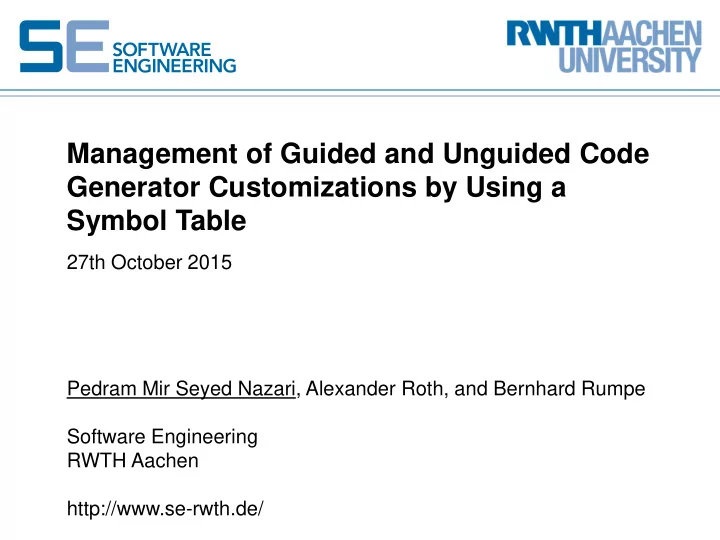

Management of Guided and Unguided Code Generator Customizations by Using a Symbol Table 27th October 2015 Pedram Mir Seyed Nazari, Alexander Roth, and Bernhard Rumpe Software Engineering RWTH Aachen http://www.se-rwth.de/
Chair of Software Engineering Motivation RWTH Aachen University Seite 2 In Model-Driven Development detailed code is generated from abstract models • models may be too abstract to describe every detail A possible solution: • customizations and adaptations of the code generator Basic customization of template-based code generation • directly adapt templates • disadvantage: affect all generated artifacts using this template
Chair of Software Engineering Contribution RWTH Aachen University Seite 3 Two approaches for customizing templated-based generators • Guided approaches: restricted customization • Unguided approaches: unrestricted customizations Derive the information that should be managed Derive necessary extensions for template languages
Chair of Software Engineering Guided Customization Approaches RWTH Aachen University Seite 4 inserts a value Explicit declaration of spots that can be extended to a spot in T3 • e.g. variability points T2 T3 All other ways of customization are explicitly forbidden Required main elements for template-based code generation • hook points: are uniquely identifiable spots defined for customization • hook points are set during the design time • content for each hook point needs to be bound explicitly • bounded values are either strings or other templates Advantage: • extension points are explicit and can be checked statically Disadvantage: might be too restrictive
Chair of Software Engineering Requirements for Guided Customizations RWTH Aachen University Seite 5 Extended template engine in order to define and bind hook points Template T1 Template T2 TMPL TMPL ${defineHP("HP1")} ${defineHP("HP1")} ${bindHPString("p.T1.HP1","value of hp")} defines new qualified binds hook hook point hook point point name Requirements: • hook point is defined within the template and should be accessible from outside • given a (qualified name), the corresponding hook point definition must be obtained
Chair of Software Engineering Unguided Customization Approaches RWTH Aachen University Seite 6 Basic concept: directly customize the code generator by editing templates • replace templates: existing template is replaced • add before template: a template is added before an existing template • add after template: a template is added after an existing template T3 is replaced T1 by T5 Advantage: less restrictive than guided approaches T3 T5 Disadvantages: • tend to be more error prone • generator sources may not be available at generation-time • side effects as templates may be used in multiple places
Chair of Software Engineering Requirements for Unguided Customizations RWTH Aachen University Seite 7 Extended template engine in order to replace templates Analogously for adding templates before or after existing templates Template T2 TMPL ${replace("q.T3","p.T1")} replaces a template Requirements: • replacing syntactically takes place in template T2. However, each template that includes T1 must be aware of this replacement • given a (qualified name), the corresponding template definition must be obtained
Chair of Software Engineering Requirements for Managing Customizations RWTH Aachen University Seite 8 Resulting requirements for managing customizations: • manage information that is defined within that template and make it accessible (from outside) • manage information that is defined outside that template and make it accessible • given a reference, the corresponding definition must be obtained in order to access its associated information Goal: • Reuse existing infrastructures for managing customizations • Respect referential integrity
Chair of Software Engineering Symbol Table for Templates RWTH Aachen University Seite 9 Symbol table naturally fits the requirements to manage code generator customizations Definition: Symbol table • it is a data structure that maps names to essential model elements • in MontiCore it may also represent the semantic meta model Symbol table can be extended to manage • hook point management • template customizations
Chair of Software Engineering Extended Symbol Table for Templates RWTH Aachen University Seite 10 CD TemplateST global variables * * replacedBy GVSymbol TemplateSymbol 1 hook points 0..1 * * HPSymbol ReplacementSymbol templates boundTo 0..1 being replaced Value values of hook points 1 StringValue TemplateValue value
Chair of Software Engineering Example RWTH Aachen University Seite 11 Template T1 Template T2 TMPL TMPL ${defineHP("HP1")} ${defineHP("HP1")} ${defineHP("HP2")} ${bindHPString("p.T1.HP1","value of hp")} ${replace("q.T3","p.T1")} OD :TemplateST replacedBy T1:TemplateSymbol T2:TemplateSymbol T3:TemplateSymbol HP1:HPSymbol HP2:HPSymbol HP1:HPSymbol :ReplacementSymbol boundTo :StringValue value = ʺ value of hp ʺ
Chair of Software Engineering Static and Dynamic Information RWTH Aachen University Seite 12 Symbol table contains two types of information • static information: can be obtained without execution a template • dynamic information: can only be determined at generation-time By only analyzing templates: • template references and hook point symbols can be build • referential integrity can be checked Values bound to hook points can only be added at generation-time • values are not static and can change during execution A combination of static and dynamic information allows for efficient management of customizations
Chair of Software Engineering Conclusion RWTH Aachen University Seite 13 Overview of guided and unguided customization approaches for template-based code generation • Goal: retrieve basic elements that need to be managed Provide requirements for a data structure to efficiently manage customizations Adapt the symbol table to manage customizations • Add hook points and template references Combine static and dynamic information for efficient management
Recommend
More recommend